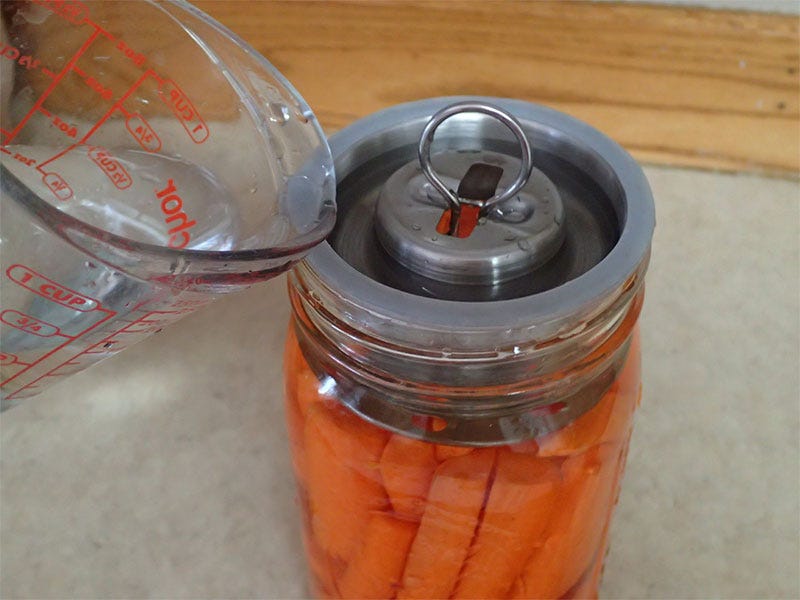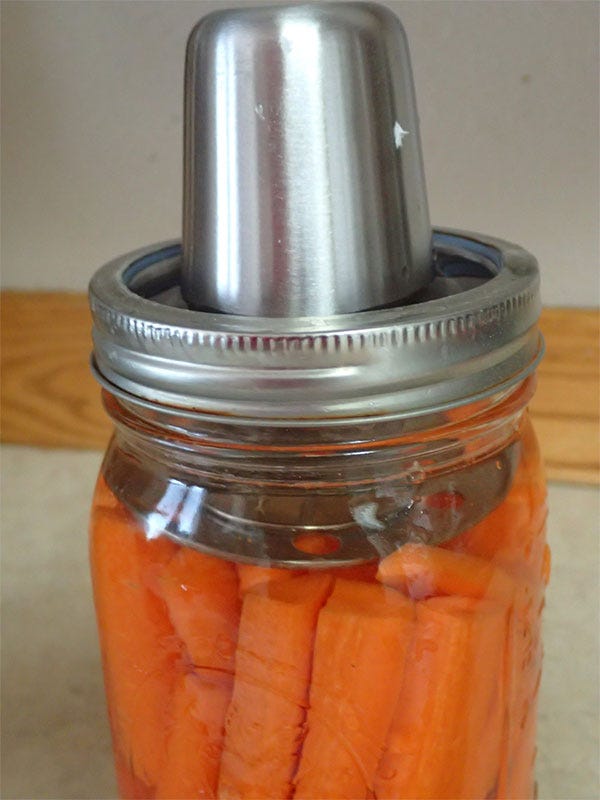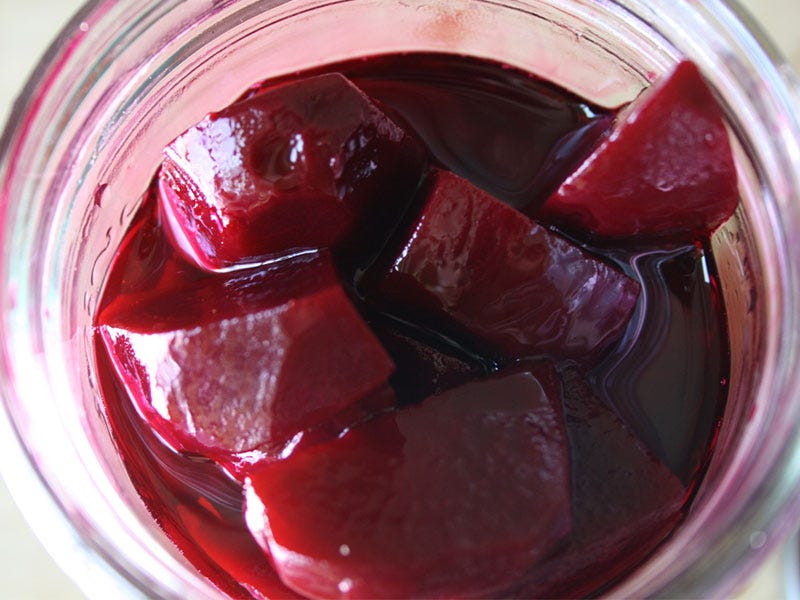Fabulous Ferments

When it comes to food safety, I take it to a whole ‘nother level. Never shall meats and vegetables touch the same surfaces during preparation, and after making chicken, the kitchen smells like a swimming pool with copious amount of the bleach I use in the clean up. So, when home fermentation started becoming popular many years ago, even with all of its nutritional benefits, I didn’t know if I was going to be able to do have food soaking in brine on the counter for a week or more, possibly with white fuzz growing somewhere on the liquid, and actually eat it.
Thankfully, speaking with Sandor Katz (a.k.a. Sandorkraut), author of Wild Fermentation and The Art of Fermentation, alleviated my fears. His decades of research and international experience convinced me that I wasn’t going to kill my family, and in fact, fermenting food will actually make them healthier.
Now nearly everything is fair game in the crock or at least in a jar to see how it turns out. Radishes are a springtime treat, fermented beets turn something I love into something even better, and sauerkraut is a native food in my German heritage. And I know I’ve barely scratched the surface learning about the different vegetables, and the new tools, to make easy and delicious food for my family.
 Chopping carrots to ferment
Chopping carrots to fermentThe magic of fermentation
Fermentation controls the spoilage of food, which was a difficult concept for me to wrap my head around, but once I learned how it works, it made more sense. In my world, bacteria and microorganisms are a bad thing, but they are the magic behind the fermentation process where they break down, basically pre-digesting the foods, because the fermentation develops the enzymes and digestive bacteria we need to optimally use them. For lactic acid fermentation, which is the typical method used on these foods, the process lowers the pH level inhibiting the bad bacteria while the good ones work their magic. As long as the brine is acidic enough, it won’t make you sick.
 Make classic pickles with fermentation
Make classic pickles with fermentationHistory of fermentation
Regardless of your ethnic background, there is some form of fermentation in your family’s food history. For mine, Germans who lived in Hungary for well over a century, it was normal for my great-grandmother to have crocks of sauerkraut in the basement. High in vitamin C (which is why sailors took it with them on long journeys to prevent scurvy), it was an excellent way to preserve the bountiful cabbage at the end of the year. But the same holds true for most other vegetables resulting in delicious and unique flavors.
 Making sauerkraut is one answer to too much cabbage
Making sauerkraut is one answer to too much cabbageWhat can you ferment
The short answer to what foods you can ferment is pretty much anything. I’ve spoken with people who ferment everything from kale to eggs or meat. But for the rookie, the easiest way to start is to choose a vegetable you like. Of course, sauerkraut is an excellent gateway ferment, but so are carrots, beets, radishes, and so many other vegetables.
 Carrots in a jar to ferment.
Carrots in a jar to ferment.Pick your equipment
Grandma Ripp used a big crock with a plate and a weight in the basement. There was nothing fancy, which is the beauty of this process. It is the ultimate in low tech. But since I don’t want or need gallons of kraut, I’ve reduced my container size over the years using a one-gallon Harsch crock (a wonderful tool), as well as a variety of jars. The goal is to be able to submerge the food beneath the brine because oxygen can disrupt the process and introduce microorganisms you don’t want.
This can be as simple as using a small jar filled with water to push the ingredients underneath the brine in a larger jar, or any number of the excellent air-lock systems available on the market. One of my new favorites is the Kraut Source fermentation kit because it is very similar to the Harsch crock that uses a water moat to allow gas to escape, but no oxygen can reach the food I’m fermenting. The big difference is I can make small batches in a quart jar with it instead of an entire crock.

How to go about it
There are a lot of variations you can use, including adding spices and multiple types of vegetables, but in the beginning, keep it simple. Think: Chop and submerge under the brine, and then eat it when you like it.
For sauerkraut, chop or grate your cabbage, then put it all in a large bowl. Sprinkle with a teaspoon of sea salt per 4 cups of cabbage (roughly) and start crushing the cabbage. You can use a masher of some sort or just get in there with your hands. Depending on the variety of cabbage, you’ll be surprised at how much liquid comes out of the cabbage.
Put the cabbage mix into a crock or jar and push it down. If there is not at least an inch of liquid on top of the cabbage, add more brine made up of a 1-2 tablespoons of sea salt dissolved into a quart of water. The amount of salt isn’t an exact science. It inhibits the growth of bad bacteria and slows the decomposition process, but how much you ultimately use depends on personal preferences and what you’re fermenting. After pouring in the brine to give at least an inch of liquid on the top, submerge the cabbage to keep it below the brine. This could be by using weights in a crock, a plate with a brick, another jar filled with water, or the Kraut Source press. Then set it out of the way for a few days.
The same is true for carrots, which are an incredible snack. Peel and cut a pound or two of carrots into sticks. Place them in a jar and pour the brine over top. Submerge and taste after 4-5 days. If they’re not sour enough, don’t hesitate to let them ferment for a longer time.
When you start fermenting, it’s a good idea to keep the jar close to where you can check on it. I like mine on the counter so I can taste it after a few days or a week. When it reaches the flavor and consistency that I like. I put a lid on the jar and keep it in the refrigerator to stop, or at least slow, the decomposition process.
 Add the top to allow the gases to escape gradually.
Add the top to allow the gases to escape gradually.Enjoy every day
A little goes a long way with fermented foods. You don’t need to eat an entire bowl to reap the benefits of this superfood. A couple of spoonfuls does wonders to boost your gut health and better your digestion.
 Beets are fabulous when fermented
Beets are fabulous when fermentedHave fun with fermentation
If I can chill out and enjoy my fermented vegetables, you can, too. As the garden matures and the vegetables ripen rapidly, think about fermenting some of your favorites. Do a batch of carrots, or try kohlrabi, which makes a delightfully crisp snack. When your counter top looks like a culinary science experiment, you know you’re living right.
 You can use one jar within another to submerge vegetables.
You can use one jar within another to submerge vegetables.
